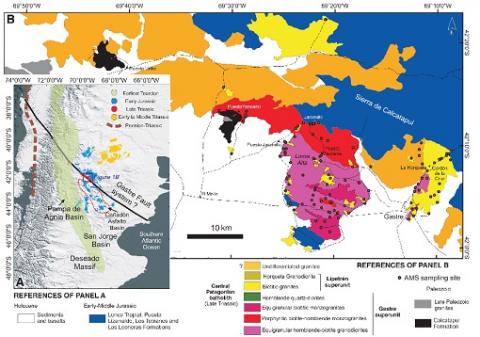Claudia B. Zaffarana; Rubén Somoza; Darío L. Orts; Roberto Mercader; Bárbara Boltshauser; Víctor Ruiz González; Carla Puigdomenech
2 017
GeoScienceWorld Geosphere (2017) 13 (6): 1973-1992.
The Central Patagonian batholith (CPB) comprises two Late Triassic calcalkaline plutonic suites (the Gastre superunit of 221 ± 2 Ma and the Lipetrén superunit of 215 ± 1 Ma) which have been interpreted as a record of major dextral motion along the transcontinental NW-SE–striking subvertical Gastre fault system in Jurassic times. We performed a detailed study of the internal structure of the CPB through structural and anisotropy of magnetic susceptibility (AMS) techniques. The Gastre superunit reveals a very consistent pattern of NW-SE–striking steeply dipping magmatic foliations. Tectonic fabrics within the CPB are scarce and generally parallel to the magmatic fabrics. The magmatic and solid-state lineations within the CPB are steeply, intermediately, or shallowly plunging. The combination of flattened magmatic and solid-state fabrics with subvertical orientations and with steep to shallow lineations, together with the kinematic indicators in two mylonite belts with suspected CPB protoliths, suggests that the Gastre superunit was emplaced within a sinistral transpressive regime. The shallower stocks of the Lipetrén superunit are more isotropic and have magmatic fabrics associated with magma chamber dynamics. The deformation of the CPB is coaxial with the late Paleozoic deformation in the hosting Calcatapul Formation. The late Paleozoic deformation in the North Patagonian Massif generated widespread NW-SE subvertical fractures which could have aided the emplacement of the CPB. The internal structure of the CPB does not support a model of dextral strike-slip movements on major Jurassic faults.

